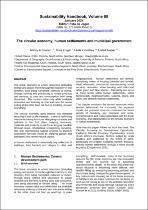JavaScript is disabled for your browser. Some features of this site may not work without it.
- ResearchSpace
- →
- Research Publications/Outputs
- →
- Book Chapters
- →
- View Item
| dc.contributor.author |
Cooper, Antony K

|
|
| dc.contributor.author |
Kruger, Tinus

|
|
| dc.contributor.author |
Godfrey, Linda K

|
|
| dc.contributor.author |
Napier, Mark

|
|
| dc.contributor.editor | De Jager, Peta | |
| dc.date.accessioned | 2024-02-20T09:02:40Z | |
| dc.date.available | 2024-02-20T09:02:40Z | |
| dc.date.issued | 2024-01 | |
| dc.identifier.citation | Cooper, A.K., Kruger, T., Godfrey, L.K. & Napier, M. 2024. The circular economy, human settlements and municipal government. In <i>Sustainability Handbook Volume 8</i>. P. De Jager, Ed. S.l.: Alive2Green. http://hdl.handle.net/10204/13606 . | en_ZA |
| dc.identifier.isbn | 9780620452403 | |
| dc.identifier.uri | http://hdl.handle.net/10204/13606 | |
| dc.description.abstract | The linear economy is where resources (including energy and space) move through the economy in one direction, from being harvested, collected or mined, through refining and processing to create products and services, to uses and consumption, until being discarded. This creates value only while available resources are entering at one end and the waste exiting at the other does not foul up anything, or even everything.This chapter considers the current resources within human settlements for circularity, the expected trends, the potential resource constraints for future growth of circularity, key economic and socio-economic gains and losses associated with the linear economy, and opportunities for the circular economy in human settlements. | en_US |
| dc.format | Fulltext | en_US |
| dc.language.iso | en | en_US |
| dc.publisher | Alive2Green | en_US |
| dc.relation.uri | https://sustainability-handbook.alive2green.co.za/magazine/vol8/ | en_US |
| dc.source | Sustainability Handbook Volume 8 | en_US |
| dc.subject | Human settlements | en_US |
| dc.subject | Linear economy | en_US |
| dc.subject | Circular economy | en_US |
| dc.subject | Governance | en_US |
| dc.subject | Standards | en_US |
| dc.subject | Recycling | en_US |
| dc.subject | Construction | en_US |
| dc.subject | Sustainable buildings | en_US |
| dc.title | The circular economy, human settlements and municipal government | en_US |
| dc.type | Book Chapter | en_US |
| dc.description.pages | 86-109 | en_US |
| dc.description.placeofpublication | Cape Town | en_US |
| dc.description.note | Note that this paper follows on from the book, The Circular Economy as Development Opportunity: Exploring Circular Economy Opportunities across South Africa’s Economic Sectors, edited by Linda Godfrey and published by the CSIR in 2021, particularly the chapter, Creating resilient, inclusive, thriving human settlements through a more circular economy [Cooper et al 2021]. | en_US |
| dc.description.cluster | Smart Places | en_US |
| dc.description.cluster | Hosted National Programmes | en_US |
| dc.description.impactarea | Housing and Urban Studies | en_US |
| dc.description.impactarea | Waste RDI Implementation Unit | en_US |
| dc.identifier.apacitation | Cooper, A. K., Kruger, T., Godfrey, L. K., & Napier, M. (2024). The circular economy, human settlements and municipal government. In P. De Jager. (Ed.), <i>Sustainability Handbook Volume 8</i> Alive2Green. http://hdl.handle.net/10204/13606 | en_ZA |
| dc.identifier.chicagocitation | Cooper, Antony K, Tinus Kruger, Linda K Godfrey, and Mark Napier. "The circular economy, human settlements and municipal government" In <i>SUSTAINABILITY HANDBOOK VOLUME 8</i>, edited by Peta De Jager. n.p.: Alive2Green. 2024. http://hdl.handle.net/10204/13606. | en_ZA |
| dc.identifier.vancouvercitation | Cooper AK, Kruger T, Godfrey LK, Napier M. The circular economy, human settlements and municipal government. In De Jager P, editor.. Sustainability Handbook Volume 8. [place unknown]: Alive2Green; 2024. [cited yyyy month dd]. http://hdl.handle.net/10204/13606. | en_ZA |
| dc.identifier.ris | TY - Book Chapter AU - Cooper, Antony K AU - Kruger, Tinus AU - Godfrey, Linda K AU - Napier, Mark AB - The linear economy is where resources (including energy and space) move through the economy in one direction, from being harvested, collected or mined, through refining and processing to create products and services, to uses and consumption, until being discarded. This creates value only while available resources are entering at one end and the waste exiting at the other does not foul up anything, or even everything.This chapter considers the current resources within human settlements for circularity, the expected trends, the potential resource constraints for future growth of circularity, key economic and socio-economic gains and losses associated with the linear economy, and opportunities for the circular economy in human settlements. DA - 2024-01 DB - ResearchSpace DP - CSIR ED - De Jager, Peta J1 - Sustainability Handbook Volume 8 KW - Human settlements KW - Linear economy KW - Circular economy KW - Governance KW - Standards KW - Recycling KW - Construction KW - Sustainable buildings LK - https://researchspace.csir.co.za PY - 2024 SM - 9780620452403 T1 - The circular economy, human settlements and municipal government TI - The circular economy, human settlements and municipal government UR - http://hdl.handle.net/10204/13606 ER - | en_ZA |
| dc.identifier.worklist | 27624 | en_US |






